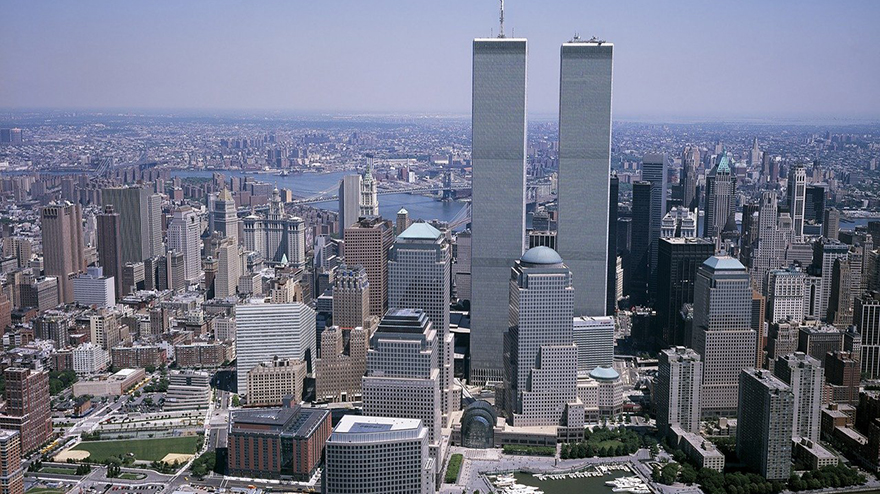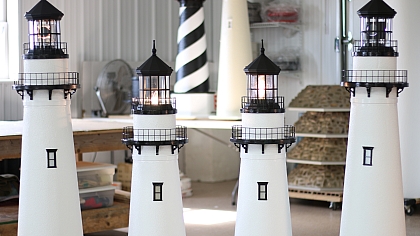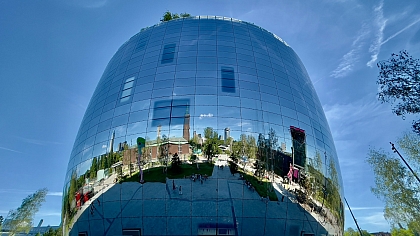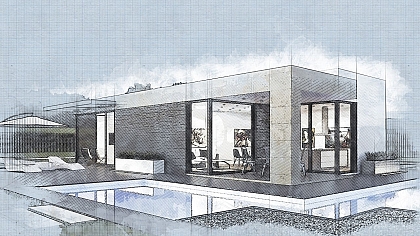
15 Brilliant United States Architects You’d Love to Know 1894 - 1913
1. Paul Revere Williams 1894 – 1980
Paul Revere Williams was an American architect from Los Angeles, California, US.
Early Life & Education
Paul R. Williams was born on 18th February 1894 in Los Angeles, California. His father was Chester Stanley and his mother was Lola Wright Williams. His parents died at an early age. He attended the Los Angeles School of Art and Design and later at the Beaux-Arts Institute of Design. He studied architecture at the University of Southern California, graduating in 1919.
Career & Projects
In 1921, Paul Revere Williams joined the architect John C. Austin as a chief draftsman and worked till 1924. Soon Paul R Williams started his architectural practice. He collaborated with architect Edwin Wallace Neff to design small Airform structures for housing.
His notable projects include Williams Residence; Pueblo del Rio Housing Development; First Church of Christ, Scientist; Beverly Sunset Medical Center, Los Angeles; and others.
Recognition
Paul R Williams was the winner of the AIA Award of Merit for the MCA Building, Beverly Hills.
He died on 23rd January 1980 in Los Angeles, California.
2. R. Buckminster Fuller 1895 – 1983
R. Buckminster Fuller was an American architect and designer. He was an inventor, author and futurist. He is widely recognized for his design of a geodesic dome. He was the second president of Mensa International, the largest high-IQ society worldwide.

Early Life & Education
R. Buckminster Fuller was born on 12th July 1895 in Milton, Massachusetts, America. His father was Richard Buckminster Fuller and his mother was Caroline Wolcott Andrews. He spent the early years of his life at Bear Island, Penobscot Bay, Maine. He went to Froebelian Kindergarten. He usually made things and tools out of materials that he found in the woods. When he was only 12 years old, he experimented and invented a new propelling system of ‘push-pull’ for a small row boat using an umbrella in an inverted position that was connected with the transom to direct the boat to the required destination.
He enrolled at the Milton Academy, Massachusetts. Later he began his studies at Harvard University but was expelled from the university two times because of being irresponsible and lacking interest.
He got married to Anne Hewlett in 1917. He had a daughter Alexandra who died in year 1922 when she was not even four years old. In 1927, he had another daughter Allegra.
Career & Projects
During their early years, R. Buckminster Fuller worked in the textile industry as a mechanic. Later he worked in a meat packing factory as a laborer. During the First World War, he worked in the US Navy as an operator of shipboard radio. He also served as an editor as well as commander for the USS Inca crash rescue boat.
During the 1920s, he along with his father-in-law James Monroe Hewlett established the Stockade Building System that manufactured weather-secure, lightweight, fireproof and affordable housing.
When Fuller was 32 years old in 1927, he lost the position of president at the Stockade Building System.
In 1928, he spent a lot of time at a famous café, Marie Marchand’s (Romany Marie) cafe in Greenwich Village. He designed the interiors of the café and accepted the meals as his design fee. He often gave lectures there. His experimental designs of the Dymaxion house were displayed at the café. Marie’s old acquaintance Constantin Brancusi, a Romanian artist and sculptor introduced Japanese American landscape architect and artist Isamu Noguchi to Fuller. Isamu Noguchi and R Buckminster Fuller worked on many projects together and produced the best architecture.
Some of his most remarkable projects include the Dymaxion house; R. Buckminster Fuller and Anne Hewlett Dome Home; Tokyo Tower; Tokyo Olympic Stadium; Aerodynamic Dymaxion car; Dymaxion deployment unit; Prefabricated bathroom cell; Ford Motor Company Geodesic Dome; Fly’s Eye Dome; Geodesic Dome for Dewan Tunku, Penang, Malaysia; Montreal Biosphere, Canada and many others.
He wrote and published more than thirty theoretical works on systems theory and design.
Buckminster Fuller died on 1st July 1983 in Los Angeles, California at the age of 87 years.
3. Pietro Belluschi 1899 – 1994
Pietro Belluschi was an influential American architect, born in Italy. He was a proponent of the modern architecture movement. He served as the dean at the School of Architecture and Planning, MIT.
Early Life & Education
Pietro Belluschi was born on 18th August 1899 in Ancona, Italy. He gave his service in the Italian army during the First World War. When the war was over, he attended the University of Rome to study civil engineering and graduated in 1922. In 1923, he went to America to study civil engineering again at Cornell University.
Career & Projects
Pietro Belluschi initially worked as a draftsman in Oregon. He joined the studio of architect A. E. Doyle based in Portland. He became a partner in the firm in 1933 after A. E. Doyle passed away in 1928.
Pietro Belluschi served as the Dean at the School of Architecture of the Massachusetts Institute of Technology.
His notable buildings are the Cathedral of Saint Mary of the Assumption; Equitable Building; Pan Am Building and many others.
Recognition
Pietro Belluschi received the AIA Gold Medal in 1972. He was also honoured with the National Medal of Arts.
He died on 14th February 1994
4. Louis Kahn 1901 – 1974
Louis Kahn was an American architect. He taught at the Yale School of Architecture. He also taught architecture at the University of Pennsylvania. He was among the most prominent architects of the 20th century.

Early Life & Education
Louis Isadore Kahn or Itze-Leib Schmuilowsky was born on 5th March 1901 in Kuressaare, Livonia (Estonia), Russian Empire. His father was Leopold Schmuilowsky and his mother was Bertha Schmuilowsky. His family moved to the US in 1906. He studied architecture at the School of Fine Arts of the University of Pennsylvania graduating in 1924.
Career & Projects
Louis I Kahn joined the office of architect John Molitor as a draftsman in 1924. He went on a Europe tour in 1928. When he came back to the US the next year, he first joined Paul Philippe Cret and later Zantzinger, Borie and Medary, Philadelphia.
Louis I Kahn established the Architectural Research Group in 1932 along with Dominique Berninger.
Louis Isadore Kahn established his firm in 1935. In 1947, he taught at Yale University. Later in 1957, he began teaching at the University of Pennsylvania.
Louis Kahn buildings are Philips Exeter Academy Library; Salk Institute; Yale University Art Gallery; Kimbell Art Museum; Indian Institute of Management, Ahmedabad and several others.
Esherick House is a famed house designed by architect Louis Kahn located in Philadelphia. It is among the other nine famous houses designed by the American architect on modern lines. Margaret Esherick, the client of the house commissioned its construction. It was finished in 1961. It is also known as Margaret Esherick House.
Recognition
Louis Kahn's architecture won the AIA Gold Medal. Louis Isadore Kahn was honoured with the RIBA Gold Medal. He died on 17th March 1974 in New York City, US.
5. Edward Durell Stone 1902 – 1978
Edward Durell Stone was an influential American architect widely recognized for his highly embellished designs.
Early Life & Education
Edward Durell Stone was born on 9th March 1902 in Fayetteville, Arkansas. His grandfather Stephen Stone was a wealthy man of the town. His father, Benjamin Hicks Stone, ran the family business and his mother, Ruth S. Johnson, was an educator at the University of Arkansas Preparatory School. As Edward Durell Stone showed an early interest in art and drawings, he studied sketching and woodworking.
His elder brother James Hicks Stone was an architect practising in Boston. Edward Durell Stone shifted to Boston in the year 1922 when he joined the studio of Strickland, Blodgett & Law as an office boy. Meanwhile, he began taking night classes at the Boston Architectural Club (BAC) where he met the famed architect Henry Shepley who hired him as a draftsman in his firm. Edward Durell Stone was honoured with a scholarship to study architecture at the School of Architecture of Harvard University in 1925. In 1926, he studied at the MIT. He travelled to Europe to further his studies in 1927.
Career & Projects
Edward Durell Stone designed various residences in the International Style during the 1930s. During the later years of his career, his style changed from modernist architecture towards classical style with contemporary building materials and technologies.
Some of his notable projects are the Museum of Modern Art; Henry R. Luce Residence, South Carolina; El Panama Hotel; US Embassy, New Delhi; John F. Kennedy Center for the Performing Arts, Washington; US Pavilion, 1958 World’s Fair, Brussels; University of Islamabad; Harvey Mudd College; Medical Center, University of Arkansas and several others. His key clients also included the National Geographic Society; General Motors, Pepsico and Standard Oil.
Recognition
Edward Durell Stone won the Gold Medal of Honor from the Architectural League in 1952 for El Panama Hotel. He achieved the American Institute of Architects Honor Award in 1967.
Edward Durell Stone died on 6th August 1978.
6. Bruce Goff 1904 – 1982
Bruce Goff was a great American architect. He was well known for his eclectic, organic and glamorous architectural designs for residences and other structures built in Oklahoma and other areas. Bruce Goff won the American Institute of Architects AIA Twenty-Five Year Award in 1987.
Early Life & Education
Bruce Alonzo Goff was born on 8th June 1904 in Alton, Kansas, America. His father, Corliss, worked for his own business of watch repairing. He moved to Tulsa with his family. Bruce Goff attended school in Skiatook where his parents shifted again. He was impressed by the Mormon Temple located in Salt Lake City. He developed his interest in architecture. He painted influenced by nature and drew flamboyant sketches of buildings. His parents moved to Denver Colorado in 1913. Bruce Goff often went to bed without food due to unpleasant financial conditions. In 1915, his family relocated to Tulsa where Bruce Goff attended Lincoln Elementary School. He apprenticed at the architectural studio of Rush, Endacott & Rush in Tulsa when he was only 12 years old.
Career & Projects
Bruce Goff designed McGregor House in the early days. During this time, he communicated with Louis Sullivan and Frank Lloyd Wright who encouraged Bruce to learn architecture and design from Rush, Endacott & Rush architectural firm instead of getting formal education from Massachusetts Institute of Technology. They thought that formal training could hinder his creativity. He was a self-taught architect. In 1930, he became a partner in the firm.
Bruce Goff designed Boston Avenue Methodist Church, US and Tulsa Club Building.
Bruce Goff moved to Chicago in 1934. He taught at the Academy of Fine Arts as well as designed various projects. He taught at the University of Oklahoma’s School of Architecture in 1942 and worked on projects at the same time. He moved his office to Bartlesville, Oklahoma.
His other famous projects are the Pavilion for Japanese Art; Bachman House; Glen Mitchell House; Ledbetter House; Ruth VanSickle Ford House; Bayinger House; and others.
Recognition
Bruce Goff won the AIA Twenty-Five Year Award in 1987.
He died on 4th August 1982 in Tyler, Texas, America when he was 78 years old.
7. Bernard Rudofsky 1905 – 1988
Bernard Rudofsky was an Austrian American architect, designer and artist. He was also a writer, an educator and a social historian. He is well known for his famed book, Architecture Without Architects: A Short Introduction to Non-Pedigreed Architecture. It was published in 1964 and is about vernacular architecture with its cultural, functional and artistic richness.
Early Life & Education
Bernard Rudofsky was born on 19th April 1905 in Moravia in Austro Hungarian Empire. He achieved his Ph. D in architecture in Austria.
Career & Projects
Bernard Rudofsky worked in several different countries including Italy and Germany. During the 1930s, he started his architectural firm in Brazil where he worked on many projects in Sao Paulo. He got the opportunity to travel to the US through MOMA and stayed in America. He was inspired by indigenous architecture. He taught at the Massachusetts Institute of Technology; Yale University; Cooper Hewitt; Royal Academy of Fine Arts, Copenhagen and Waseda University, Toyko.
Bernard Rudofsky died on 12th March 1988.
8. Gordon Bunshaft 1909 – 1990
Gordon Bunshaft was an American architect. He was one of the partners of Skidmore, Owings & Merrill architectural firm. His famed projects are Hirshhorn Museum & Sculpture Garden; Beinecke Rare Book & Manuscript Library and Lever House.
Early Life & Education
Gordon Bunshaft was born on 9th May 1909 in Buffalo, New York, US.
Earlier, he studied at the Lafayette High School. He completed his graduation in architecture in 1933 from the Massachusetts Institute of Technology and received his post-graduation degree in architecture from the same institute in 1935.
Career & Projects
Gordon Bunshaft joined the studio of Edward Durell Stone and later he worked for Raymond Loewy. Soon he joined the architectural firm Skidmore, Owings & Merrill (SOM Architecture).
He worked for the Office of Foreign Building Operations of the State Department for collaborating on American Embassies in Germany. His designs were inspired by Le Corbusier and Ludwig Mies van der Rohe.
Some of his notable projects are Hirshhorn Museum & Sculpture Garden, Washington; Beinecke Rare Book & Manuscript Library, Yale University; Lever House, New York; National Commercial Bank, Jeddah, KSA; Manufacturers Hanover Trust Branch Bank, New York and others.
Recognition
Gordon Bunshaft received the AIA Twenty-Five Year Award in 1980. He also won the Pritzker Architecture Prize in 1988.
Gordon Bunshaft died on 6th August 1990 in New York at the age of 81 years.
9. Eero Saarinen 1910 – 1961
Eero Saarinen was a Finnish-American architect as well as an industrial designer. He is well regarded for his architectural designs for the Gateway Arch, Missouri, TWA Flight Center, New York and Washington Dulles International Airport, Washington.
Early Life & Education
Eero Saarinen was born on 20th August 1910 in Kirkkonummi, Finland, Russian Empire. His father Eliel Saarinen was a prominent architect who also taught furniture design and sculpture at the Cranbrook Academy of Art, Bloomfield Hills, Michigan. In 1929. Eero Saarinen moved to America with his family in 1923.
Eero Saarinen studied sculpture at the Academie de la Grande Chaumiere, Paris in 1929. He received his architecture education from the Yale School of Architecture, graduating in 1934. He visited North Africa and Europe. He went back to America after two years.
Career & Projects
In 1936, when he returned, he joined his father’s architectural studio Saarinen, Swansen & Associates, based in Bloomfield Hills, Michigan that was later relocated to Hamden, Connecticut.
His significant projects are Gateway Arch, St. Louis; TWA Flight Center, JFK International Airport, New York; Washington Dulles International Airport, Washington; Crow Island School, Winnetka, Illinois; General Motors Technical Center, Warren, Michigan; University of Chicago Law School; Noyes dormitory, Vassar; Ezra Stiles and Morse College, Yale University; Kresge Auditorium, MIT; Hill College House, University of Pennsylvania; Ingalls ice rink, Yale; Kleinshans Music Hall, New York; US Embassy, London; US Embassy, Oslo and others. He also designed creative furniture such as a Tulip chair; Womb chair; Womb settee and Grasshopper lounge chair.
When his father passed away in 1950, he founded his architectural practice, Eero Saarinen & Associates. His firm executed several projects such as Gateway Arch National Park, St. Louis, Missouri; East Air Terminal, Athens airport, Greece; Bell Labs Holmdel Complex, Holmdel Township; Miller House, Columbus; Shapiro Dormitory, Sherman Student Center, Ridgewood Quadrangle at Brandeis University; Cranbrook Science Insitute; Cranbrook Art Academy; Kingswood School and others.
Recognition
He won the AIA First Honor award in 1955 and again in 1956. He was honoured with the American Institute of Architects Gold Medal in 1962.
He died at the age of 51 years on 1st September 1961 in Ann Arbor, Michigan, America while having a brain tumour surgery.
10. Eliot Noyes 1910 – 1977
Eliot Noyes was an American architect. He was also an industrial designer. He designed projects for the International Business Machines Corporation IBM Aerospace Research Center, Los Angeles, California and the IBM Selectric typewriter.
Early Life & Education
Eliot Fette Noyes was born on 12th August 1910 in Boston, Massachusetts, America. At first, he desired to become a painter.
Eliot Noyes enrolled at Harvard College to study Classics where he was influenced by Le Corbusier’s architectural masterpieces. His interest grew in architecture and he received his architecture education from Harvard Graduate School of Design, graduating in 1938.
Career & Projects
After completing his studies, he worked for Marcel Breuer and Walter Gropius’ studio based in Cambridge, Massachusetts. He became a director of industrial design at the Museum of Modern Art in 1939. He held this position till 1946. He also worked for Norman Bel Geddes & Company as an industrial designer.
His key projects are Jackson House, Dover; Tallman House; Bremer House; Noyes House; Weeks House; Ault House; bubble houses, Hobe Sound, Florida; Wilton Library; and others.
Eliot Noyes died on 18th July 1977 in Connecticut, America at the age of 66.
11. Minoru Yamasaki 1912 – 1986
Minoru Yamasaki was an American architect. He is globally recognized for his design for the World Trade Center, in New York as well as other massive-scale projects.
Early Life & Education
Minoru Yamasaki or Yamasaki Minoru was born on 1st December 1912 in Seattle, Washington, America. His father was John Tsunejiro Yamasaki and his mother was Hana Yamasaki.
He began studying architecture at the University of Washington in 1929 and finished his graduation in 1934. He went to Manhattan after his studies. He found a job in an importing firm before he worked as an engineer. He got into New York University for his master’s program in architecture.
Career & Projects
Minoru Yamasaki joined the architecture company, Shreve, Lamb and Harmon Architects, which designed the Empire State Building. Later he joined Raymon Loewy and Harrison & Abramovitz. He went to Detroit in 1945 and worked for Smith, Hinchman & Grylls till 1949. He began his practice, Yamasaki & Associates, during the same year. His designs were inspired by the architectural style of ‘New Formalism’ and vertical narrow windows and other features of Gothic Architecture.

Some of his notable projects are World Trade Center, New York; Torre Picasso; IBM Building; Rainier Tower; Federal Reserve Bank, Richmond, Ruhl’s Bakery, Detroit; Pacific Science Center, Seattle World’s Fair 1962; Pruittlgoe housing, St. Louis; Lambert St. Louis International Airport; Dhahran International Airport, Saudi Arabia; Great Lake Sales building, Reynolds Metal Company; North Shore Congregation Israel, Illinois; Temple Beth El, Michigan and others.
Minoru Yamasaki died on 6th February 1986 in Detroit, Michigan, America.
12. William Wesley Peters 1912 – 1991
William Wesley Peters was an American architect and engineer. He was one of the best architects in the world.
Early Life & Education
William Wesley Peters was born on 12th June 1912 in Terre Haute, Indiana, America. His father, Frederick Romer Peters, was an editor and his mother, Claire Adelaide, was an activist. He studied at the Evansville College. He later studied at the Massachusetts Institute of Technology for two years only.
Career & Projects
Instead of finishing his studies at MIT, he began his internship with Frank Lloyd Wright. He worked on several projects for Taliesin Associated Architects such as Van Wezel Performing Arts Hall, Sarasota; Kaden Tower, Kentucky; Pearl Palace or Shams Palace, Iran and San Jose Center for the Performing Arts, California.
When F. L. Wright died in 1959, William Wesley Peters became the chairperson of the firm. He also became the chairperson of the Frank Lloyd Wright Foundation in the year 1985. William Wesley Peters died on 17th July 1991 in Madison, Wisconsin, America at the age of 79 years.
13. Carl Koch 1912 – 1998
Carl Koch was an influential American architect from the 20th-century era of architecture. He was well recognized for Techcrete construction, prefabricated house designs and mass architecture.
Early Life & Education
Albert Carl Koch was born on 11th May 1912 in Milwaukee, Wisconsin, US. He received his education from Harvard College and completed his post-graduation in architecture from the Harvard University Graduate School of Design in 1937. During the Second World War, he went to serve in the Navy.
Career & Projects
Carl Koch shifted to Sweden and joined the office of Sven Markelius for a short period of 6 months. He designed the projects there inspired by Scandinavian architecture.
Carl Koch established his own architecture and design firm, Carl Koch & Associates. He focused on the idea of a building system where structures can be easily built, dismantled and reassembled. As a result, he developed the prefabrication system and modular architecture. His building system of Techcrete (Techbuilt) employed prefabricated panelling for building floors, walls and roofing. Techbuilt technology used to post and beam construction that used standardized external wall panels and non-loadbearing internal partitions. This allowed the design to be flexible.
Some of his famed projects are Spruce Hill Road, Massachusetts; Ocean Village, New York; Eliot House; Snake Hill, Massachusetts and others.
Recognition
Carl Koch received the AIA Award in 1954.
He died on 3rd July 1998 in Cambridge, Massachusetts, US.
14. Joseph Allen Stein 1912 – 2001
Joseph Allen Stein was an American architect and is known for his contribution to the development of modernist architecture in San Francisco during the 1940s. He worked on several projects in India including the Indian Institute of Management Kozhikode.
Early Life & Education
Joseph Allen Stein was born on 19th April 1912 in the city of Omaha, Nebraska. He received his education from the University of Illinois and the Beaux-Arts de Paris. Later he studied at the Cranbrook Academy of Art.
Career & Projects
Joseph Allen Stein joined the office of architect Ely Jacques Kahn in the state of New York. He moved to Los Angeles where he worked for Richard Neutra. He founded his studio in San Francisco. He designed numerous houses in San Francisco. He also emphasized the idea of low-cost housing. He was energetically involved in the activities of Telesis which was a team of architects, urbanists and landscape architects from San Francisco and the University of California and whose aim was to provide the best solutions to the design problems.
Joseph Allen Stein went to India in 1952 and served as the head of the school of architecture of the Bengal Engineering College, Calcutta. He got the opportunity to work on Durgapur planning in West Bengal, India in 1955 with architect Benjamin Polk.
His other major projects are Durgapur, West Bengal, India; school of the American Embassy; Australian Embassy, Chanakyapuri; Triveni Kala Sangam, New Delhi; Gandhi King Plaza; conservatory of the World Wide Fund for Nature; United Nations Children’s Fund; India International Centre; Ford Foundation; Express Towers and others.
Recognition
Joseph Allen Stein won the Padma Shri award from the Government of India in 1992.
He died on 6th October 2001 in Raleigh, North Carolina when he was 89 years old.
15. Bertrand Goldberg 1913 – 1997
Bertrand Goldberg was an influential industrial designer of the 20th century and an architect of American origin. He was well recognized for his architectural design of the Marina City project, in Chicago, Illinois. It was the tallest building in the world in reinforced concrete when it was finished.
Early Life & Education
Bertrand Goldberg was born on 17th July 1913 in Chicago, Illinois. He initially studied at the Cambridge School of Landscape Architecture, Harvard University. When he was eighteen years old, he moved to Germany for his studies at the Bauhaus. While he was studying at the institute, he worked with famed architect Ludwig Mies van der Rohe.
Career & Projects
Bertrand Goldberg left Berlin due to the political chaos and went to Paris in the year 1933. After spending some time there, he moved to Chicago. He worked with architects Paul Schweikher, Keck & Keck and Howard T. Fisher.
Bertrand Goldberg began his studio in 1937 based in Chicago.
Some of his highly recognized projects are River City, Chicago; Old Prentice Women's Hospital; North Pole ice cream shops; Good Samaritan Hospital, Arizona; Providence Hospital, Alabama; Stony Brook University Hospital; Astor Tower Hotel and several others.
Bertrand Goldberg died on 8th October 1997 at the age of 84 years.










